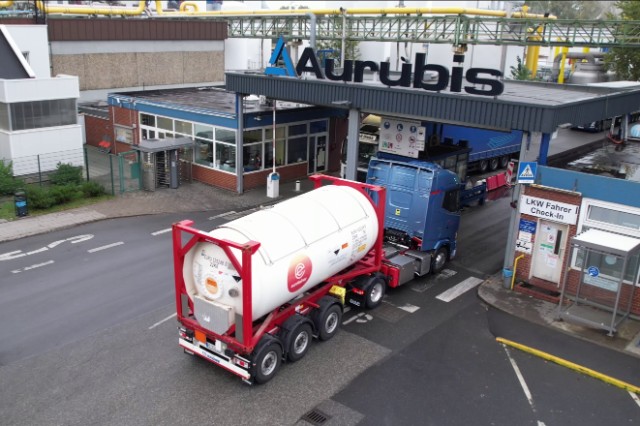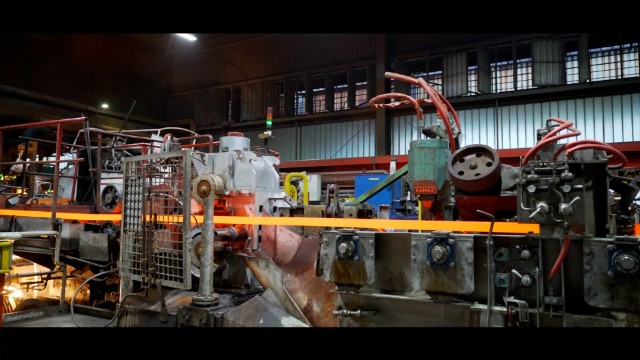
Press Release
Environmentally friendly metals: Aurubis concludes ammonia tests and plans to intensify cooperation with ADNOC
Hamburg | Friday, November 10, 2023


- Ammonia ideal carrier for new energy source hydrogen; additional building block in decarbonization strategy
- Further cooperation with ADNOC targeted to expand the first joint hydrogen supply chain
- Aurubis CEO Roland Harings: “Through our R&D, we will continue to advance the use of carbon-free energy in production”
On the path towards carbon-neutral production well before 2050, multimetal manufacturer and copper recycler Aurubis AG is decisively driving the use of innovative, carbon-free energy sources: As part of its comprehensive decarbonization strategy, the company has now successfully completed a test series using ammonia instead of natural gas in industrial production at the Hamburg plant. Following testing, Aurubis is pursuing strategic cooperation in the area of hydrogen with ADNOC, the supplier of the low-carbon ammonia for the test series in Aurubis’ production. Today, both companies signed a letter of intent.
“Aurubis views itself as responsible for helping shape the green transformation in industry, which is why we’re laying the groundwork for new, fossil-free energy sources,” Aurubis CEO Roland Harings said.
In a strategic partnership with ADNOC, we see the potential to expand our first joint hydrogen supply chain, and therefore to push the decarbonization of our copper production forward.

Roland Harings
Chief Executive Officer
To achieve the transition to comprehensive sustainability, Germany's industry needs new, climate-neutral energy sources. This applies in particular to the energy-intensive production of metals. In turn, secure metal raw materials are crucial to the success of the green transformation. Without energy security there can be no raw materials transition, and without raw materials security there can be no energy transition. The expansion of supply cooperations and partnerships for alternative, low-emission energy sources is therefore an important contribution to the German federal government's goal of advancing energy security.
Ammonia is composed of nitrogen and hydrogen and burns without generating any CO2. The ammonia used in Aurubis’ testing arrived in Hamburg as part of a joint hydrogen project between the United Arab Emirates and Germany. Last October, ADNOC delivered low-carbon ammonia produced with natural gas to Hamburg by container vessel. Green ammonia made using renewable energy currently isn’t available on the market in sufficient quantities for industrial applications.
During the test series, which ran for several months, Aurubis successfully used ammonia as an energy source in the copper wire rod production facility. The facility processes copper cathodes into copper wire rod at temperatures of over 1,100° C. The wire rod is the precursor for products such as electricity and telecommunication cables, which play a central role in the energy transition and digitalization.
“The successful testing of ammonia in copper wire rod production proved that from a technical standpoint, we are capable of using this energy source as an admixture on an industrial scale,” Harings said. The roughly 20 % ammonia admixture target Aurubis originally envisioned proved unfeasible in view of environmental regulations and high product quality standards, however. As a result, Aurubis does not plan to pursue the direct use of ammonia as a fuel in this area of application. The company is pushing hydrogen use instead, which has been successfully tested in other areas of copper production. “In hydrogen derivative ammonia and in hydrogen itself, we see great opportunities for saving natural gas and as such avoiding CO2 emissions,” Harings emphasized.
Both energy sources will help us continue decarbonizing our processes and achieve our ambitious climate protection goals.

Roland Harings
Chief Executive Officer
In addition to its use as a fuel, ammonia has the ideal properties for serving as a hydrogen carrier. Energy can be efficiently transported over great distances and stored using ammonia, since it offers high energy density with the same volume – taking up less space. The technology used to recover the hydrogen from the ammonia by splitting the gas back into hydrogen and nitrogen is called a cracker. Aurubis is already reviewing the potential for developing an ammonia cracker. This would allow the further expansion of the hydrogen value chain with partners like ADNOC in the future, subject to economic viability.
As part of a joint research project with partners from industry and the scientific community, Aurubis will now focus on the direct use of hydrogen in the copper wire rod production plant. “Through intensive research and development, we will continue to identify the potential of ammonia as a hydrogen carrier – and especially the potential of hydrogen itself – as a carbon-free energy source and further advance its use in our production,” Harings said. “The findings from the ammonia test series serve as a valuable foundation here and are another milestone along our path to carbon-neutral production.”
Hamburg's Senator for Economic Affairs Melanie Leonhard (Social Democratic Party) described Aurubis' new hydrogen activities as "another important decarbonization step by a key industrial player in our city." The Hamburg Ministry of Economics and Innovation supported the test series at Aurubis. Leonhard continued: "Hamburg wants to develop into Europe's leading hydrogen metropolis. However, this will only work if local companies not only participate in this development, but also drive it forward. Aurubis' commitment is the best example of this."
In 2021, Aurubis showed that hydrogen can be successfully used in copper production. A pilot project at the Hamburg plant used hydrogen instead of natural gas in the production of copper anodes – the first use of hydrogen on an industrial scale. Furthermore, the Hamburg plant will be one of the first copper smelters in the world to use hydrogen instead of natural gas for the reduction process in its anode furnaces: Aurubis is investing € 40 million in new anode furnaces that will be powered by green hydrogen. The tests were carried out as part of the Northern German Living Lab joint project with the Hamburg University of Applied Sciences as a scientific partner.
Aurubis has pursued the strategic goal of consistently minimizing the impacts of production on the environment and climate for a long time. This clear focus on sustainability has paid off: Aurubis produces a number of metals with less than half the average CO2 emissions of its global competitors. The carbon footprint of the main product, copper cathodes, has decreased by 36 % since 2013. Furthermore, the footprint of its plants is more than 60 % lower than the global industry average. The figures for tin are even better: Aurubis is 76 % below the global average. The company’s target is for production to be carbon-neutral well before 2050.
Downloads
-
Um die heruntergeladene Komponente zu sehen den QR code scannen
Press Release
PDF
1 MB

Christoph Tesch
Head of Corporate Communications
| Mobile | +49 172 4382 388 |

Meino Hauschildt
Manager Corporate Communications, Spokesperson
| Phone | +49 40 7883-3037 |